stop start MITSUBISHI OUTLANDER 2019 (in English) User Guide
[x] Cancel search | Manufacturer: MITSUBISHI, Model Year: 2019, Model line: OUTLANDER, Model: MITSUBISHI OUTLANDER 2019Pages: 451, PDF Size: 58.02 MB
Page 138 of 451
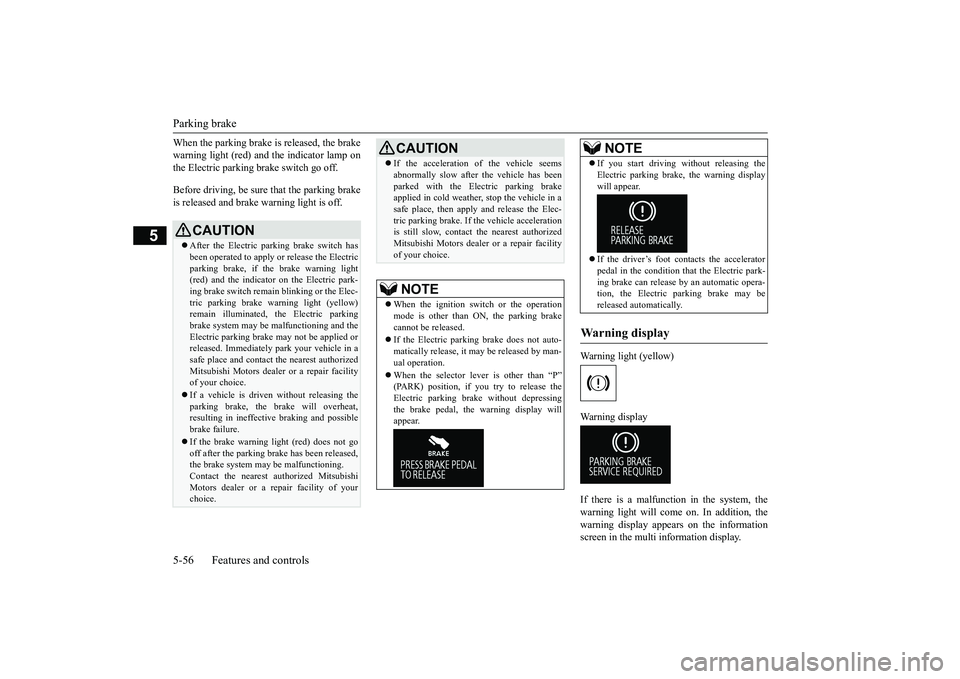
Parking brake 5-56 Features and controls
5
When the parking brake is released, the brake warning light (red) and
the indicator lamp on
the Electric parking brake switch go off. Before driving, be sure that the parking brake is released and brake
warning light is off.
Warning light (yellow) Warning display If there is a malfunction in the system, the warning light will come
on. In addition, the
warning display appears on the information screen in the multi information display.
CAUTION After the Electric parking brake switch has been operated to apply
or release the Electric
parking brake, if the brake warning light(red) and the indicator
on the Electric park-
ing brake switch remain blinking or the Elec- tric parking brake warning light (yellow)remain illuminated, the Electric parking brake system may be
malfunctioning and the
Electric parking brake
may not be applied or
released. Immedi
ately park your vehicle in a
safe place and contact
the nearest authorized
Mitsubishi Motors dealer
or a repair facility
of your choice. If a vehicle is driven without releasing the parking brake, the brake will overheat, resulting in ineffectiv
e braking and possible
brake failure. If the brake warning light (red) does not go off after the parking br
ake has been released,
the brake system may be malfunctioning. Contact the nearest authorized Mitsubishi Motors dealer or a re
pair facility of your
choice.
If the acceleration of the vehicle seems abnormally slow after
the vehicle has been
parked with the Elec
tric parking brake
applied in cold weather,
stop the vehicle in a
safe place, then apply and release the Elec- tric parking brake. If
the vehicle acceleration
is still slow, contact the nearest authorized Mitsubishi Motors dealer
or a repair facility
of your choice.NOTE
When the ignition switch or the operation mode is other than ON, the parking brakecannot be released. If the Electric parki
ng brake does not auto-
matically release, it ma
y be released by man-
ual operation. When the selector lever is other than “P” (PARK) position, if you try to release the Electric parking brak
e without depressing
the brake pedal, the warning display will appear.CAUTION
If you start driving without releasing the Electric parking brake,
the warning display
will appear. If the driver’s foot contacts the accelerator pedal in the condition th
at the Electric park-
ing brake can release
by an automatic opera-
tion, the Electric parking brake may be released automatically.
Warning display
NOTE
BK0264300US.book 56 ページ 2018年2月28日 水曜日 午後5時16分
Page 146 of 451

Ignition switch (if so equipped) 5-64 Features and controls
5
When the ignition switch is turned from the “ACC” position, the power is supplied againto those devices.
N00550901211
When removing the key, first set the selectorlever to the “P” (PARK) position, and thenturn the key to the “OFF” position and remove it.
When removing the key, first set the selector lever to the “P” (PARK) position, and push the key in at the “ACC” position and keep it depressed until it is turned to the “LOCK”position, and remove it.
NOTE
It is possible to modify functions as follows: • The time until the power cuts out can be changed to approximately 60 minutes. • The ACC power auto
-cutout function can
be deactivated. For details, we recommend you to consult an authorized Mitsubishi Motors dealer.On vehicles equippe
d with the Smartphone
Link Display Audio, sc
reen operations can
be used to make the adjustment.Refer to the separate
owner’s manual for
details.
To remove the key
Ty p e 1
NOTE
The key cannot be rem
oved unless the selec-
tor lever is set to the “P” (PARK) position,which allows the ignition switch to turn to the “OFF” position.
Ty p e 2
NOTE
The key cannot be rem
oved unless the selec-
tor lever is set to the “P” (PARK) position, which allows the ignition switch to turn tothe “LOCK” position.CAUTION If the engine is stoppe
d while driving, the
power brake booster will stop functioning and greater effort for braking will be required. Also, the power steering systemwill not function and it
will require greater
effort to manually steer the vehicle. Do not leave the key in
the “ON” position for
a long time when the engine is not running. This will cause the battery to run down. Do not turn the key to the “START” position when the engine is ru
nning. It will damage
the starter motor.
BK0264300US.book 64 ページ 2018年2月28日 水曜日 午後5時16分
Page 153 of 451

Automatic transaxle (if so equipped)
Features and controls 5-71
5
N00514201425
This position locks the transaxle to prevent the vehicle from moving.
The engine can be
started in the “P” (PARK) position. Move the lever to this position only after the vehicle has come to a complete stop. At this position, the transaxle is disengaged. It is the same as th
e neutral position on a
manual transaxle and should be used when the vehicle is not moving for an extended length of time during driving, such as in atraffic jam.
This position is used for most city and high- way driving. The transaxle will automatically change its gear depe
nding on road and driv-
ing conditions.
This position is for dr
iving up very steep hills
and for engine braking at low speeds when driving down steep hills.
N00514401485
While the vehicle is stopped or being drivenwith the selector lever in the “D” (DRIVE) or “L” (LOW) position, sports mode can be selected by pulling one of the sportronicsteering wheel paddle shifter towards you. In sports mode, rapid shifting is possible sim- ply by operating the spor
tronic steering wheel
paddle shifter. Unlike the manual transaxle, sports mode allows shifting with the accelerator pedaldepressed.
Selector lever positions
“P” PARK
“R” REVERSE
CAUTION Never shift into the “P” (PARK) or “R” (REVERSE) position while the vehicle is in motion. If the lever is shifted into the “P” (PARK) or “R” (REVERSE) position whilethe vehicle is in moti
on, the transaxle may be
damaged.
“N” NEUTRAL
WA R N I N G Never move the selector lever to the “N” (NEUTRAL) position while driving sinceyou could accidentally slip it into the “P”(PARK) or “R” (REVERSE) position, damaging the transaxle. To prevent the vehicle from rolling when stopped on a slope,
the engine should be
started in the “P” (PARK) position, not in“N” (NEUTRAL) position. To prevent rolling, always keep your foot on the brake pedal when the vehicle is in “N” (NEUTRAL) positi
on, or when shift-
ing into or out of
“N” (NEUTRAL) posi-
tion.
“D” DRIVE
CAUTION To prevent transaxle damage, never shift into the “D” (DRIVE) position from the “R” (REVERSE) position while the vehicle is in motion.
“L” LOW
WA R N I N G This position can be used for maximum engine braking. Be very careful not to shift into “L” (LOW) suddenly.Sudden engine braking may cause the tires to skid. Select this position according to the roadconditions and vehicle speed.
Sports mode
BK0264300US.book 71 ページ 2018年2月28日 水曜日 午後5時16分
Page 156 of 451
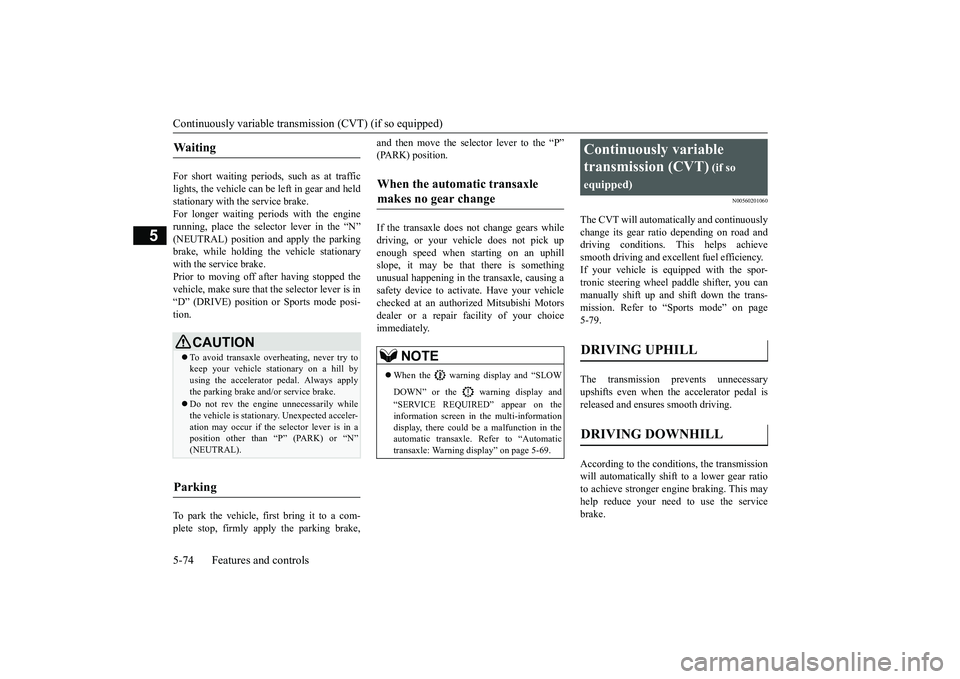
Continuously variable transmission (CVT) (if so equipped) 5-74 Features and controls
5
For short waiting periods, such as at traffic lights, the vehicle can be
left in gear and held
stationary with the service brake.For longer waiting periods with the engine running, place th
e selector lever in the “N”
(NEUTRAL) position a
nd apply the parking
brake, while holding the vehicle stationary with the service brake. Prior to moving off after having stopped the vehicle, make sure that
the selector lever is in
“D” (DRIVE) position or
Sports mode posi-
tion. To park the vehicle, first bring it to a com- plete stop, firmly apply the parking brake,
and then move the sele
ctor lever to the “P”
(PARK) position. If the transaxle does not change gears while driving, or your vehicle does not pick up enough speed when starting on an uphillslope, it may be that there is something unusual happening in the transaxle, causing a safety device to activa
te. Have your vehicle
checked at an authorized Mitsubishi Motors dealer or a repair facility of your choiceimmediately.
N00560201060
The CVT will automati
cally and continuously
change its gear ratio depending on road anddriving conditions. This helps achieve smooth driving and excellent fuel efficiency. If your vehicle is equipped with the spor- tronic steering wheel paddle shifter, you can manually shift up and shift down the trans-mission. Refer to “Sports mode” on page 5-79. The transmission prevents unnecessary upshifts even when the accelerator pedal is released and ensures smooth driving. According to the conditions, the transmission will automatically shift to a lower gear ratioto achieve stronger engine braking. This may help reduce your need to use the service brake.
Waiting
CAUTION To avoid transaxle over
heating, never try to
keep your vehicle stat
ionary on a hill by
using the accelerator
pedal. Always apply
the parking brake and/or service brake. Do not rev the engine unnecessarily while the vehicle is stationary. Unexpected acceler-ation may occur if the selector lever is in a position other than “P” (PARK) or “N” (NEUTRAL).
Parking
When the automatic transaxle makes no gear change
NOTE
When the warning display and “SLOW DOWN” or the warning display and “SERVICE REQUIRED” appear on the information screen in
the multi-information
display, there could be a malfunction in theautomatic transaxle. Refer to “Automatic transaxle: Warning di
splay” on page 5-69.
Continuously variable transmission (CVT)
(if so
equipped)DRIVING UPHILL
DRIVING DOWNHILL
BK0264300US.book 74 ページ 2018年2月28日 水曜日 午後5時16分
Page 159 of 451
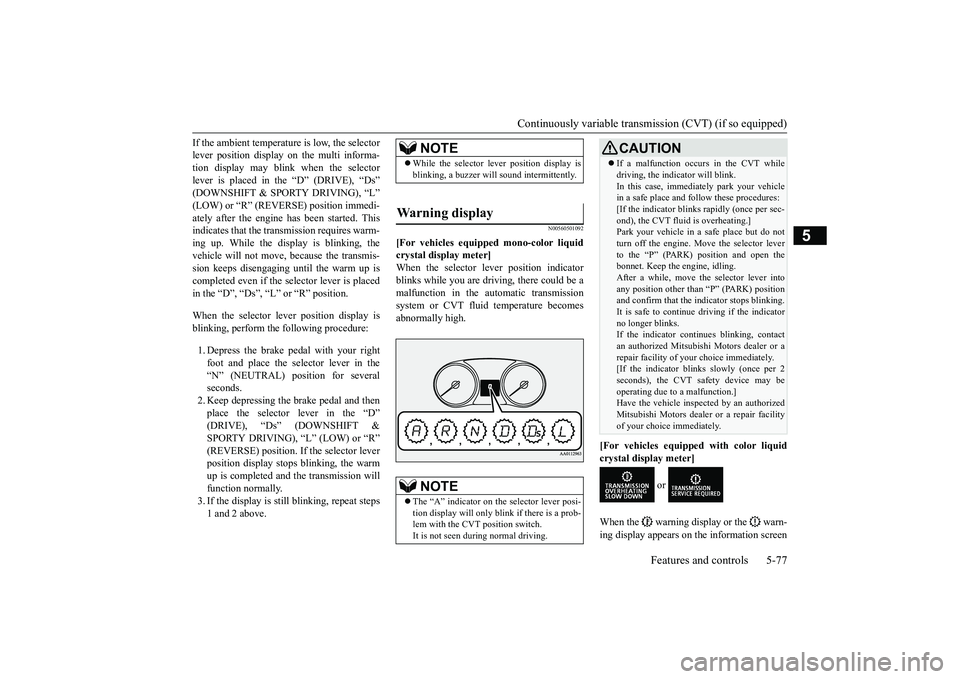
Continuously variable transmission (CVT) (if so equipped)
Features and controls 5-77
5
If the ambient temperature is low, the selector lever position display on the multi informa-tion display may blink when the selector lever is placed in the “D” (DRIVE), “Ds” (DOWNSHIFT & SPORTY DRIVING), “L”(LOW) or “R” (REVER
SE) position immedi-
ately after the engine has been started. This indicates that the tran
smission requires warm-
ing up. While the display is blinking, the vehicle will not move,
because the transmis-
sion keeps disengaging until the warm up is completed even if the selector lever is placed in the “D”, “Ds”, “L” or “R” position. When the selector lever position display is blinking, perform th
e following procedure:
1. Depress the brake pedal with your right foot and place the se
lector lever in the
“N” (NEUTRAL) position for severalseconds. 2. Keep depressing the brake pedal and then place the selector lever in the “D”(DRIVE), “Ds” (DOWNSHIFT & SPORTY DRIVING), “L” (LOW) or “R” (REVERSE) position. If the selector leverposition display stops
blinking, the warm
up is completed and the transmission will function normally.3. If the display is still
blinking, repeat steps
1 and 2 above.
N00560501092
[For vehicles equipped mono-color liquid crystal display meter]When the selector lever position indicator blinks while you are driving, there could be a malfunction in the automatic transmissionsystem or CVT fluid temperature becomes abnormally high.
[For vehicles equipped with color liquid crystal display meter]
or
When the warning display or the warn- ing display appears on
the information screen
NOTE
While the selector lever position display is blinking, a buzzer will
sound intermittently.
Warning display
NOTE
The “A” indicator on th
e selector lever posi-
tion display will only blink if there is a prob-lem with the CVT position switch. It is not seen during normal driving.
CAUTION If a malfunction occurs in the CVT while driving, the indicator will blink.In this case, immediat
ely park your vehicle
in a safe place and follow these procedures: [If the indicator blinks
rapidly (once per sec-
ond), the CVT fluid is overheating.]Park your vehicle in
a safe place but do not
turn off the engine. M
ove the selector lever
to the “P” (PARK) position and open thebonnet. Keep the engine, idling. After a while, move the selector lever into any position other than
“P” (PARK) position
and confirm that the in
dicator stops blinking.
It is safe to continue driving if the indicator no longer blinks.If the indicator conti
nues blinking, contact
an authorized Mitsubish
i Motors dealer or a
repair facility of your
choice immediately.
[If the indicator blinks slowly (once per 2 seconds), the CVT sa
fety device may be
operating due to a malfunction.]Have the vehicle insp
ected by an authorized
Mitsubishi Motors dealer or a repair facility of your choice immediately.
BK0264300US.book 77 ページ 2018年2月28日 水曜日 午後5時16分
Page 160 of 451
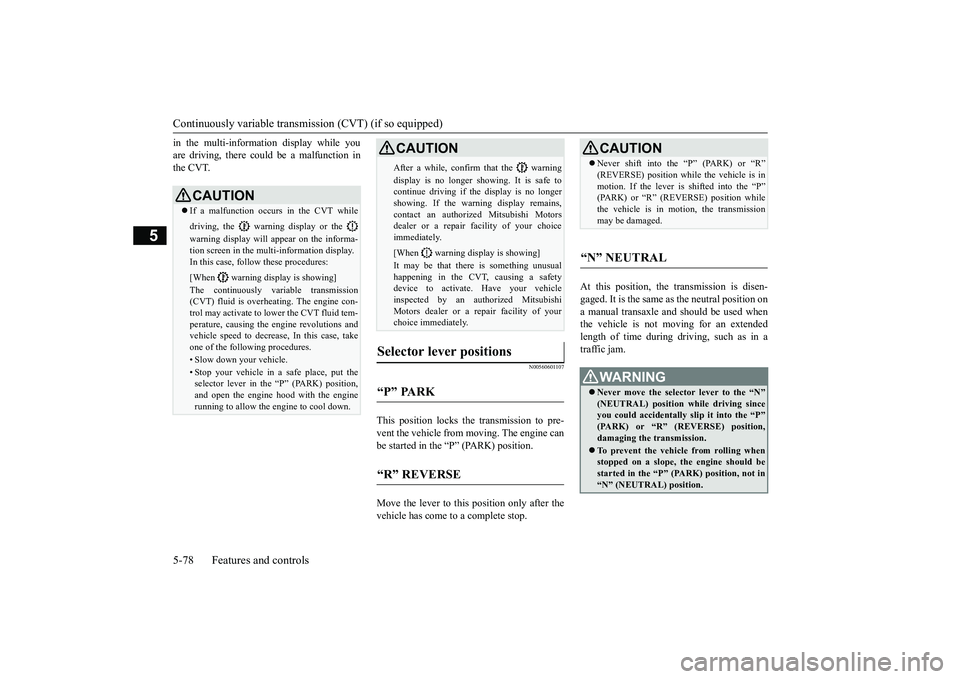
Continuously variable transmission (CVT) (if so equipped) 5-78 Features and controls
5
in the multi-information display while you are driving, there could be a malfunction inthe CVT.
N00560601107
This position locks the transmission to pre-vent the vehicle from m
oving. The engine can
be started in the “P” (PARK) position. Move the lever to this position only after the vehicle has come to a complete stop.
At this position, the transmission is disen- gaged. It is the same
as the neutral position on
a manual transaxle and should be used whenthe vehicle is not m
oving for an extended
length of time during driving, such as in a traffic jam.
CAUTION If a malfunction occurs in the CVT while driving, the warning display or the warning display will
appear on the informa-
tion screen in the multi-information display. In this case, follow these procedures: [When warning display is showing] The continuously variable transmission (CVT) fluid is overhea
ting. The engine con-
trol may activate to lower the CVT fluid tem-perature, causing the e
ngine revolutions and
vehicle speed to decrease, In this case, take one of the following procedures.• Slow down your vehicle.• Stop your vehicle in a
safe place, put the
selector lever in the “P” (PARK) position, and open the engine hood with the enginerunning to allow the engine to cool down.
After a while, confirm that the warning display is no longer show
ing. It is safe to
continue driving if the display is no longer showing. If the warning display remains, contact an authorized Mitsubishi Motorsdealer or a repair facility of your choice immediately. [When warning di
splay is showing]
It may be that ther
e is something unusual
happening in the CVT, causing a safetydevice to activate
. Have your vehicle
inspected by an authorized Mitsubishi Motors dealer or a repair facility of yourchoice immediately.
Selector lever positions
“P” PARK
“R” REVERSE
CAUTION
CAUTION Never shift into the “P” (PARK) or “R” (REVERSE) position while the vehicle is inmotion. If the lever is shifted into the “P”(PARK) or “R” (REVERSE) position while the vehicle is in motion, the transmission may be damaged.
“N” NEUTRAL
WA R N I N G Never move the selector lever to the “N” (NEUTRAL) position while driving since you could accidentally
slip it into the “P”
(PARK) or “R” (REVERSE) position, damaging the transmission. To prevent the vehicle from rolling when stopped on a slope,
the engine should be
started in the “P” (P
ARK) position, not in
“N” (NEUTRAL) position.
BK0264300US.book 78 ページ 2018年2月28日 水曜日 午後5時16分
Page 163 of 451

Continuously variable transmission (CVT) (if so equipped)
Features and controls 5-81
5
To gain extra acceleration in “D” (DRIVE) position (when passing an
other vehicle) push
the accelerator to the floor. The CVT willautomatically downshift. For short waiting periods, such as at traffic lights, the vehicle can be
left in selector lever
position and held stationary with the service brake.For longer waiting periods with the engine running, place th
e selector lever in the “N”
(NEUTRAL) position and apply the parkingbrake, while holding the vehicle stationary with the service brake. Prior to moving off after having stopped thevehicle, make sure that the selector lever is in “D” (DRIVE) position or Sports mode posi- tion.
To park the vehicle, fi
rst bring it to a com-
plete stop, firmly apply the parking brake, and then move the selector lever to the “P” (PARK) position. If the CVT does not shift while driving, or your vehicle does not pick up enough speed when starting on an uphill slope, it may bethat there is something unusual happening in the transmission, causi
ng a safety device to
activate. Have your ve
hicle checked at an
authorized Mitsubishi Motors dealer or a repair facility of your
choice immediately.
Depress the brake pedal
with the right foot at
all times.Using the left foot could cause driver move-ment delay in case of an emergency. To prevent sudden acce
leration, never run
the engine at high rpms when shifting from the “P” (PARK) or “N” (NEUTRAL). Operating the accelerator pedal while the other foot is resting
on the brake pedal will
affect braking efficiency and may cause pre-mature wear of brake pads. Use the selector lever in the correct shift position in accordance
with driving condi-
tions. Never coast downhill backward in the driv-ing shift position {“
D” (DRIVE), “DS”
(DOWN SHIFT & SPORTY DRVING), “L” (LOW) position or sports mode} or coastforward in the “R” (REVERSE) position. Engine stopping and increased brake pedal and steering effort could
lead to an accident.
Do not rev the engine
with the brake pedal
pressed when the vehicle is stationary.This can damage the CVT. Also, when you depress
the accelerator pedal
while holding down the brake pedal with theselector lever in th
e “D” (DRIVE) position,
the engine revolutions
may not rise as high
as when performing the same operation withthe selector lever in the “N” (NEUTRAL) position.CAUTION
Passing acceleration
NOTE
In sports mode, downshi
fts do not take place
when the accelerator is depressed all the wayto the floor.
Waiting
CAUTION To avoid transmission overheating, never try to keep your vehicle stationary on a hill byusing the accelerator
pedal. Always apply
the parking brake and/or service brake. Do not rev the engine unnecessarily while the vehicle is stationary. Unexpected acceler- ation may occur if the se
lector lever is in a
position other than “P” (PARK) or “N”(NEUTRAL).
Parking
When the CVT makes no speed change
BK0264300US.book 81 ページ 2018年2月28日 水曜日 午後5時16分
Page 165 of 451

Electronically controlled 4WD system (if so equipped)
Features and controls 5-83
5
N00549401030
Normally the indicator illuminates when the operation mode put in ON, and then the drivemode is displayed a few seconds after the engine is started. The status of each drive mode display is asfollows.
On vehicles with color liquid crystal display meter, the drive mode is displayed as an inter-rupt display on the information screen in the multi information display when the drive mode is switched.After a few seconds, th
e information screen
returns from the drive mode display to the previous screen.
Driving on dry, paved roads in “4WD LOCK” mode causes increased fuel con-sumption and noise.NOTE
The drive mode can be switched while driv- ing or stopped.
Drive mode indicator
Drive Mode
Drive mode indicatorcolor liquid crystal dis-play meter
mono-color liquid crys- tal display meter
4WD ECO 4WD ECO 4WD-E 4WD AUTO 4WD AUTO — 4WD LOCK 4WD LOCK LOCK
CAUTION
Drive mode
Display
4WD ECO 4WD AUTO 4WD LOCK
CAUTION If the selected drive
mode indicator begins
blinking, the drive mode will automaticallyswitch to protect the drive-system compo-nents. A warning will
also be displayed in
the information screen in the multi informa- tion display. Warning display (color
liquid crystal dis-
play) Reduce speed and, if the indicator stops blinking, you may resume normal driving. For vehicles equipped with mono-color liq- uid crystal display mete
r, drive mode indica-
tor (“4WD-E”, “LOCK”) is blinking alternately
BK0264300US.book 83 ページ 2018年2月28日 水曜日 午後5時16分
Page 170 of 451

4-wheel drive operation 5-88 Features and controls
5
When turning a sharp corner in “4WD LOCK” (Electronically controlled 4WD) or “LOCK” (S-AWC) position at low speed, a
slight difference in
steering may be experi-
enced similar to feeling as if the brakes wereapplied. This is calle
d tight corner braking
and results from each of the four tires being at a different distance from the corner. The phe-nomenon is typical of 4-
wheel drive vehicles.
If this occurs, either straighten out the steer- ing wheel or change to another mode. Set the drive mode-selector to “4WD AUTO”, “4WD LOCK” (Electronically con- trolled 4WD) or “SNOW” (S-AWC) in accor- dance with the road conditions, and thengradually depress the accelerator pedal for a smooth start.
WA R N I N G Do not over-rely on th
e 4-wheel drive vehi-
cles. Even 4-wheel drive vehicles have lim-its to the system and ability to maintaincontrol and traction.
Reckless driving may
lead to accidents. Al
ways drive carefully,
taking account of the road conditions. Improperly operating
this vehicle on or
off-pavement can cause an accident orrollover in which you
and your passengers
could be seriously injured or killed.• Follow all instructio
ns and guidelines in
the owner’s manual.• Keep your speed low and do not drivefaster than conditions.NOTE
Driving on rough roads can be hard on a vehicle. Before you le
ave the pavement, be
sure all scheduled ma
intenance and service
has been done, and that you have inspected your vehicle. Pay spec
ial attenti
on to the
condition of the tires, and check the tire pres- sures. Mitsubishi Motors is not
responsible to the
operator for any damage or injury caused or liability incurred by improper and negligent operation of a vehicl
e. All techniques of
vehicle operation depe
nd on the skill and
experience of the oper
ator and other partici-
pating parties. Any de
viation from the rec-
ommended operating instru
ctions above is at
their own risk.
Note that the stopping distance required of the 4-wheel drive vehicle differs very littlefrom that of the front-wheel drive vehicle.When driving on a snow-covered road or a slippery, muddy surface,
make sure that you
keep a sufficient dist
ance between your vehi-
cle and the one ahead of you. The driving posture s
hould be more upright;
adjust the seat to a good position for easy steering and pedal operati
on. Be sure to wear
the seat belt. After driving on rough roads, check each part of the vehicle
and wash it thoroughly
with water. Refer to the “Inspection and maintenance fo
llowing rough road opera-
tion” section and “Vehic
le care and Mainte-
nance” sections.CAUTION Setting the drive mode-selector to “4WD LOCK” (Electronically
controlled 4WD) or
“LOCK” (S-AWC) position to drive on dry paved road will increa
se fuel consumption,
with possible noi
se generation.
Turning sharp corners
NOTE
On snowy or icy roads
NOTE
The use of snow tires is recommended. Maintain a safe distan
ce between vehicles,
avoid sudden braking,
and use engine brak-
ing (downshifting).CAUTION Avoid sudden braking,
sudden ac
celeration
and sharp turning. Skidding occurs and con-trol of the vehicl
e could be lost.
BK0264300US.book 88 ページ 2018年2月28日 水曜日 午後5時16分
Page 175 of 451
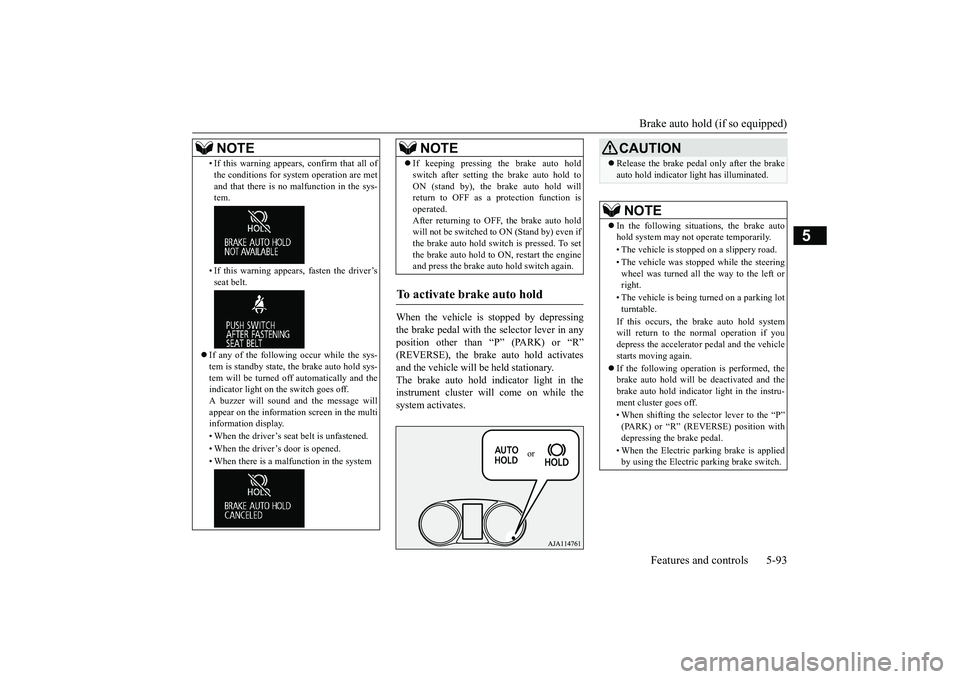
Brake auto hold (if so equipped)
Features and controls 5-93
5
When the vehicle is
stopped by depressing
the brake pedal with the selector lever in any position other than “P” (PARK) or “R”(REVERSE), the brake auto hold activates and the vehicle will be
held stationary.
The brake auto hold indicator light in theinstrument cluster will come on while the system activates.
• If this warning appear
s, confirm that all of
the conditions for system operation are metand that there is no malfunction in the sys-tem. • If this warning appears, fasten the driver’s seat belt.
If any of the following occur while the sys- tem is standby state, the brake auto hold sys-tem will be turned off automatically and the indicator light on the switch goes off. A buzzer will sound a
nd the message will
appear on the information screen in the multi information display. • When the driver’s seat
belt is unfastened.
• When the driver’s door is opened.• When there is a malfunction in the systemNOTE
If keeping pressing the brake auto hold switch after setting
the brake auto hold to
ON (stand by), the brake auto hold willreturn to OFF as a protection function is operated. After returning to OFF, the brake auto holdwill not be switched to
ON (Stand by) even if
the brake auto hold switch is pressed. To set the brake auto hold to
ON, restart the engine
and press the brake auto hold switch again.
To activate brake auto hold
NOTE
or
CAUTION Release the brake pedal only after the brake auto hold indicator li
ght has illuminated.
NOTE
In the following situations, the brake auto hold system may not
operate temporarily.
• The vehicle is stoppe
d on a slippery road.
• The vehicle was stoppe
d while the steering
wheel was turned all the way to the left or right. • The vehicle is being turned on a parking lot turntable. If this occurs, the brake auto hold system will return to the normal operation if youdepress the accelerator
pedal and the vehicle
starts moving again. If the following operation is performed, the brake auto hold will be deactivated and the brake auto hold indicator light in the instru-ment cluster goes off. • When shifting the selector lever to the “P” (PARK) or “R” (REVERSE) position with depressing the brake pedal. • When the Electric park
ing brake is applied
by using the Electric
parking brake switch.
BK0264300US.book 93 ページ 2018年2月28日 水曜日 午後5時16分